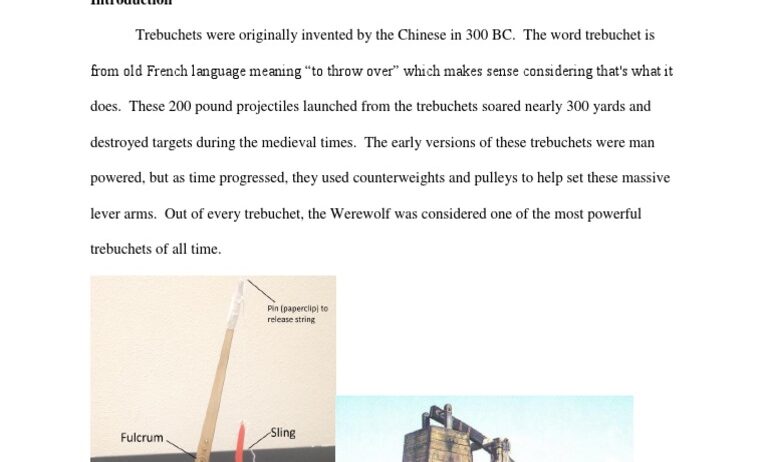Imagine standing on a vast battlefield, witnessing the awe-inspiring spectacle of a treacherous siege engine—a trebuchest—catapulting heavy projectiles into the air. What if I told you that this ancient mechanical marvel is a tribute to the principles of physics, particularly energy conservation? In this exploration of the trebuchest, we will investigate how energy is conserved in its operation while also pondering the question: Can we apply these ancient engineering principles to modern challenges, particularly in the quest for sustainable energy sources?
The trebuchest, originating in the Middle Ages, is a fascinating amalgamation of engineering ingenuity and physics. At its core, the trebuchest operates based on simple yet profound principles: potential energy, kinetic energy, and the conservation of mechanical energy. Potential energy is stored within the system when the counterweight—the component responsible for launching the projectile—is elevated. As the counterweight descends, this potential energy is transformed into kinetic energy, which is the energy of motion. Ultimately, this kinetic energy is transferred to the projectile, propelling it towards its intended target.
Let’s delve deeper into the mechanics of this wooden giant. The construction of a trebuchest typically involves a sturdy frame, a long arm, and a robust counterweight. When the counterweight is hoisted to its maximum height, it begins with a significant amount of gravitational potential energy. This energy can be calculated using the formula:
PE = mgh
Where PE is potential energy, m is mass, g is the acceleration due to gravity, and h is the height above ground. As the counterweight descends, the potential energy is converted into kinetic energy through the rotation of the arm:
KE = 1/2 mv²
Here, KE stands for kinetic energy, while v denotes velocity. The interplay of these two forms of energy is a dazzling dance of physics, demonstrating a crucial principle of energy conservation: the total mechanical energy remains constant in the absence of frictional losses.
This leads us to consider what happens when the trebuchest launches its projectile. Upon release, the spacecraft is flung through the air, its kinetic energy propelling it towards its target. Yet, at its peak, a portion of that kinetic energy is converted back into potential energy, as the projectile climbs higher in its arc. This dynamic exchange showcases energy conservation in action, a principle central to the understanding of various physical systems.
However, beyond the ancient battlefields, we encounter a contemporary challenge: the pressing need for sustainable energy solutions in the era of climate change. This begs the playful question: Could the fundamental mechanics of a trebuchest inspire innovative approaches to modern energy storage and generation? For instance, could we harness the principles of mechanical energy conservation to develop systems that capture and store renewable energy more efficiently?
One potential application lies in the concept of gravitational energy storage systems. Much akin to the trebuchest, which relies on the elevation of a counterweight, modern engineering has begun to explore the viability of storing excess energy by elevating heavy masses. Such systems could use surplus energy generated from renewable sources—wind, solar, or hydro—to lift a weight, storing energy in a manner similar to the trebuchest. When energy demand peaks, this stored gravitational potential energy could be released, transforming back into kinetic energy to generate power.
Moreover, the conservation of energy principles found in the workings of a trebuchest reveal much about the importance of efficiency in energy systems. Energy conservation is not merely a matter of preventing waste; it constitutes a crucial pillar of innovative engineering designs. Presently, efforts to optimize the energy usage in mechanical systems reflect the same principles that govern the trebuchest. Through advancements in materials science, we can develop lighter, stronger components that minimize energy losses due to friction and air resistance, ensuring a higher proportion of potential energy converts to kinetic energy.
Let’s shift our focus to the environmental implications of such systems. The potential synergy between ancient engineering and modern sustainable practices could revolutionize how we approach energy consumption and conservation. Implementing gravity-based energy storage could provide a buffer for the variability inherent in renewable energy sources while promoting a resilient electric grid. This could empower communities to mitigate the impact of climate change through a decentralized energy model, fostering energy independence and sustainability.
In conclusion, the trebuchest serves as a remarkable historical illustration of energy conservation, seamlessly interlinking potential and kinetic energy through the elegance of mechanical design. Its enduring legacy resonates today as we grapple with solutions to climate change and the urgent need for sustainable energy practices. By contemplating the interplay of ancient engineering principles and modern technology, we may indeed uncover innovative paths forward. The challenges ahead are significant, yet the lessons of the past could guide us toward a sustainable future.







